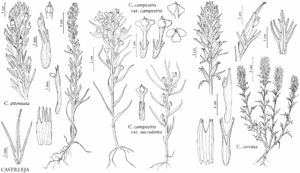Difference between revisions of "Castilleja campestris var. campestris"
IllustratedEndemic
FNA>Volume Importer |
FNA>Volume Importer |
||
| Line 49: | Line 49: | ||
|publication year= | |publication year= | ||
|special status=Illustrated;Endemic | |special status=Illustrated;Endemic | ||
| − | |source xml=https://jpend@bitbucket.org/aafc-mbb/fna-data-curation.git/src/ | + | |source xml=https://jpend@bitbucket.org/aafc-mbb/fna-data-curation.git/src/f50eec43f223ca0e34566be0b046453a0960e173/coarse_grained_fna_xml/V17/V17_1037.xml |
|genus=Castilleja | |genus=Castilleja | ||
|species=Castilleja campestris | |species=Castilleja campestris | ||
Revision as of 20:02, 16 December 2019
Herbs (0.3–)1–3 dm. Leaves linear, thin, flexible, 0.8–4 cm. Inflorescences: bracts linear, shorter than or ± equal to flowers. Calyces 7–11 mm; abaxial and adaxial clefts 3–6 mm, 45–75% of calyx length. Corollas light to bright yellow, 14–26 mm; tube 13–22 mm. Anthers: proximal pollen sac to 1/3 length of distal.
Phenology: Flowering (Mar–)Apr–Jul(–Aug).
Habitat: Vernal pools, moist ground.
Elevation: 0–2100 m.
Discussion
Variety campestris is widespread from central California to east-central Oregon, but much of its vernal pool and wet meadow habitat has been lost to agricultural development.
Selected References
None.
Lower Taxa
None.
